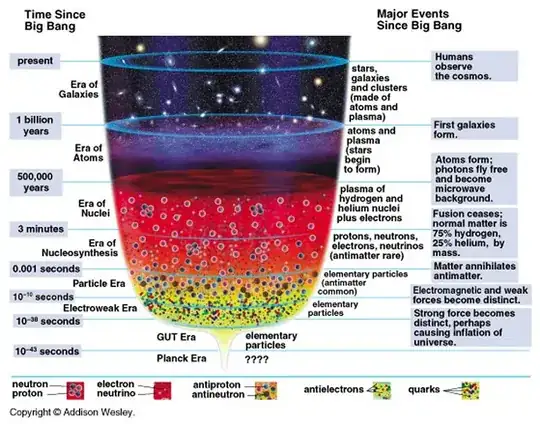Conservation of mass says that matter cannot be created or destroyed.
From this answer (below) by Luboš Motl Conservation of Energy, and also, for one example, from the idea of dark energy producing an expansion of the universe, it would seem that conservation of mass/ energy does not hold, at least in the way we view it in classical mechanics. Obviously matter was created at some stage after the Big Event, or we would not be here now.
For different mixtures of matter obeying different equations of state (roughly speaking, with different ratios of pressure and energy density), one will see the total energy increase or decrease or be constant. Generally, the total energy of the Universe will tend to increase as the Universe expands if the Universe is filled with matter of increasingly negative pressure; the total energy will decrease if it is filled with matter of increasingly positive pressure.
Your next point:
If there was no particles with mass in the universe before a Higgs Boson Field swept through the universe then what was there.
If we take the Big Bang Beginnings article as a refence for the evolution of the universe, just after the big bang, initially there may have been purely radiation, which then as the temperature dropped, became a mix of radiation and particles. We don't know exactly what happened or existed before 10$^{-12}$ second.

Image source: Timeline of the Universe
Quark Epoch, from 10$^{-12}$ seconds to 10$^{–6}$ seconds:
Quarks, electrons and neutrinos form in large numbers as the universe cools off to below 10 quadrillion degrees, and the four fundamental forces assume their present forms. Quarks and antiquarks annihilate each other upon contact, but, in a process known as baryogenesis, a surplus of quarks (about one for every billion pairs) survives, which will ultimately combine to form matter.
I don't think anybody knows how close in time (or perhaps simultaneously) the creation of the Higgs Field occurred with respect to the appearance of the 4 separate forces.
Hadron Epoch, from 10$^{–6}$ seconds to 1 second:
The temperature of the universe cools to about a trillion degrees, cool enough to allow quarks to combine to form hadrons (like protons and neutrons). Electrons colliding with protons in the extreme conditions of the Hadron Epoch fuse to form neutrons and give off massless neutrinos, which continue to travel freely through space today, at or near to the speed of light. Some neutrons and neutrinos re-combine into new proton-electron pairs.
Lepton Epoch, from 1 second to 3 minutes:
After the majority (but not all) of hadrons and antihadrons annihilate each other at the end of the Hadron Epoch, leptons (such as electrons) and antileptons (such as positrons) dominate the mass of the universe. As electrons and positrons collide and annihilate each other, energyin the form of photons is freed up, and colliding photons in turn create more electron-positronpairs.
Nucleosynthesis, from 3 minutes to 20 minutes:
The temperature of the universe falls to the point (about a billion degrees) where atomic nuclei can begin to form as protons and neutrons combine through nuclear fusion to form the nucleiof the simple elements of hydrogen, helium and lithium. After about 20 minutes, the temperature and density of the universe has fallen to the point where nuclear fusion cannot continue.
Your next question:
Lets just say that the big bang is was actually when a Higgs Boson Field swept through the tiny universe and created particles that have mass. A universe exists somewhere else and they never had a Higgs Boson Field to give their particles mass. Is that universe just a mess of gluons and photons?
Yes, without a symmetry breaking Higgs Field, all possible particles, in addition to the force carriers you mention above, would have been massless.
I apologise, but I feel the the rest of your questions in your post require a separate answer.
